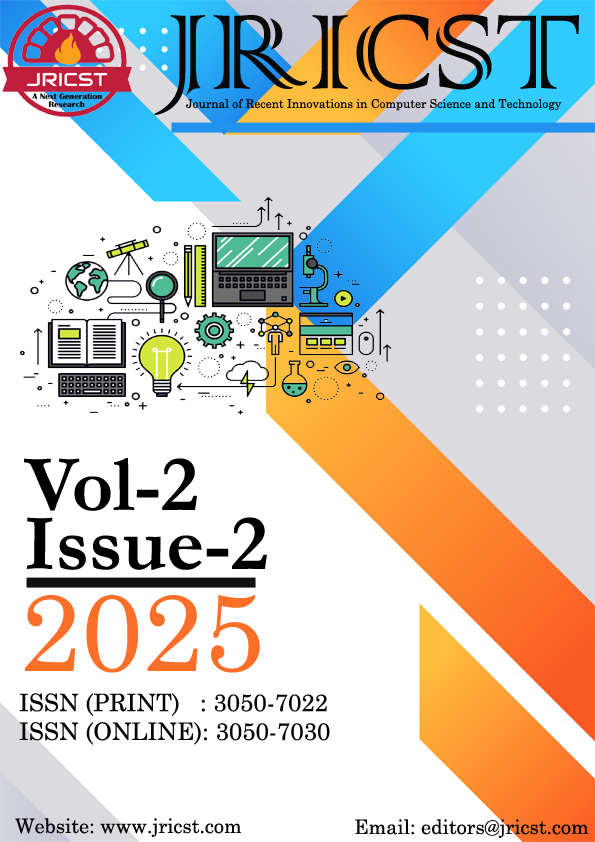ARTIFICIAL INTELLIGENCE AND CLOUD-BASED COLLABORATIVE PLATFORMS FOR MANAGING EMERGENCY OPERATIONS
DOI:
https://doi.org/10.70454/JRICST.2025.20215Keywords:
Artificial Intelligence, Cloud Computing, Real-Time Data Analysis, Emergency Management, Disaster ResponseAbstract
Emergency management operations increasingly depend on cutting-edge technological solutions to support better disaster response, resource coordination, and recovery. This research uses artificial intelligence (AI) and cloud-based collaborative platforms to enhance emergency management in pre-disaster, disaster, and post-disaster phases. AI predictive abilities allow for early risk estimation, enhancing disaster forecast accuracy by 47% for wildfires and 42% for earthquakes. In emergencies, real-time data analysis and AI automated response cut response times from 12–24 hours to 2–6 hours, boosting situational awareness and resource allocation by 55%. Cloud platforms enable real-time sharing of data between emergency responders, which promotes the number of individuals contacted within the initial 48 hours by 200% and cuts down on incident costs by 60%. The research highlights a gap in AI-based decision-making systems and the scalability of the cloud, especially in developing countries. It suggests more interdisciplinary research to create standardized AI models for emergency management. The results underscore that AI and cloud platforms improve disaster response effectiveness, resource optimization, and cost savings and overcome data security, privacy, and system integration issues.
Downloads
References
[1] Aboualola, M., Abualsaud, K., Khattab, T., Zorba, N. and Hassanein, H.S., 2023. Edge technologies for disaster management: A survey of social media and artificial intelligence integration. IEEE access, 11, pp.73782-73802.
[2] Agbehadji, I.E., Mabhaudhi, T., Botai, J. and Masinde, M., 2023. A systematic review of existing early warning systems’ challenges and opportunities in cloud computing early warning systems. Climate, 11(9), p.188.
[3] Costa, D.G., Peixoto, J.P.J., Jesus, T.C., Portugal, P., Vasques, F., Rangel, E. and Peixoto, M., 2022. A survey of emergencies management systems in smart cities. IEEE Access, 10, pp.61843-61872.
[4] Damaševičius, R., Bacanin, N. and Misra, S., 2023. From sensors to safety: Internet of Emergency Services (IoES) for emergency response and disaster management. Journal of Sensor and Actuator Networks, 12(3), p.41.
[5] Gupta, S., Modgil, S., Kumar, A., Sivarajah, U. and Irani, Z., 2022. Artificial intelligence and cloud-based Collaborative Platforms for Managing Disaster, extreme weather and emergency operations. International Journal of Production Economics, 254, p.108642.
[6] Hernández, D., Cano, J.C., Silla, F., Calafate, C.T. and Cecilia, J.M., 2021. AI-enabled autonomous drones for fast climate change crisis assessment. IEEE Internet of Things Journal, 9(10), pp.7286-7297.
[7] Khan, R.S., Sirazy, M.R.M., Das, R. and Rahman, S., 2022. An ai and ml-enabled framework for proactive risk mitigation and resilience optimization in global supply chains during national emergencies. Sage Science Review of Applied Machine Learning, 5(2), pp.127-144.
[8] Kyrkou, C., Kolios, P., Theocharides, T. and Polycarpou, M., 2022. Machine learning for emergency management: A survey and future outlook. Proceedings of the IEEE, 111(1), pp.19-41.
[9] Peyvandi, A., Majidi, B., Peyvandi, S. and Patra, J., 2021. Computer-aided-diagnosis as a service on decentralized medical cloud for efficient and rapid emergency response intelligence. New Generation Computing, 39(3), pp.677-700.
[10] Richardson, N., 2021. Emergency Response Planning: Leveraging Machine Learning for Real-Time Decision-Making. Emergency, 4, p.14.
[11] Sun, W., Bocchini, P. and Davison, B.D., 2020. Applications of artificial intelligence for disaster management. Natural Hazards, 103(3), pp.2631-2689.
[12] Velev, D. and Zlateva, P., 2023. Challenges of artificial intelligence application for disaster risk management. The International Archives of the Photogrammetry, Remote Sensing and Spatial Information Sciences, 48, pp.387-394.
[13] Velev, Dimiter&Zlateva, Plamena. (2023). CHALLENGES OF ARTIFICIAL INTELLIGENCE APPLICATION FOR DISASTER RISK MANAGEMENT. The International Archives of the Photogrammetry, Remote Sensing and Spatial Information Sciences. XLVIII-M-1-2023. 387-394. 10.5194/isprs-archives-XLVIII-M-1-2023-387-2023.
[14] Zlopasa, O., 2024. Leveraging AI for Geospatial Analysis in Flood Risk Assessment and Environmental Monitoring.
[15] Verma, K. K., & Singh, B. M. (2021, November). Vision based human activity recognition using deep transfer learning and support vector machine. In 2021 IEEE 8th Uttar Pradesh Section International Conference on Electrical, Electronics and Computer Engineering (UPCON) (pp. 1-9). IEEE.
[16] Verma, K. K., Singh, B. M., Mandoria, H. L., & Chauhan, P. (2020). Two-stage human activity recognition using 2D-ConvNet. IJIMAI, 6(2), 125-135.
[17] Verma, K. K., Kumar, P., &Tomar, A. (2015, March). Analysis of moving object detection and tracking in video surveillance system. In 2015 2nd International Conference on Computing for Sustainable Global Development (INDIACom) (pp. 1758-1762). IEEE.
Downloads
Published
Issue
Section
License
Copyright (c) 2025 Sandeep Kumar, Anurag Semwal (Author)

This work is licensed under a Creative Commons Attribution 4.0 International License.
This is an Open Access article distributed under the term's of the Creative Common Attribution 4.0 International License permitting all use, distribution, and reproduction in any medium, provided the work is properly cited.






